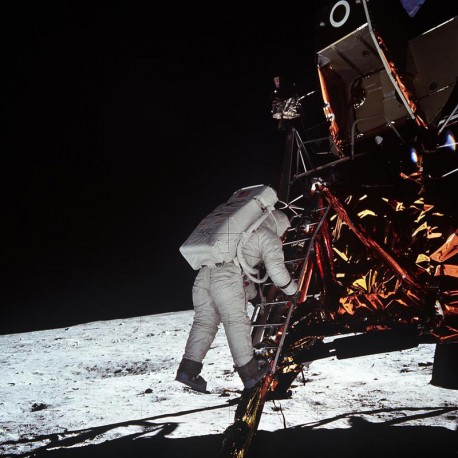 View larger
View larger
Moon Mythbusters
New activity
This is an activity about the Moon's influence on Earth.
Open Activity
-
Rating
-
Participants Enjoyed the ActivityParticipants Learned from This ActivityActivity Instructions Were Clear and Easy to FollowWould Recommend
Related Programming Resources
Reviews
A Great Start to a Library Moon Event
I used this activity along with two others (Penny Moon and Loony Lunar Phases) for a family library event for the Super Blue Blood Moon in January of 2018. The participants ranged in age from preschool through middle school and were accompanied by their caregivers.
Moon Mythbusters was a great way to start the event. I used the activity almost exactly as written, starting with asking the kids the questions in part 1 of the activity guide. Not all of the kids knew that the moon had gravity, but they all seemed to that werewolves reacted to the full moon! I had several kids that were eager to talk, so we discussed the questions and facts for about 15 minutes. I had given the kids the printed pages with the puzzle pieces at the start of the session and asked them to start cutting out the pieces while we talked. This allowed us to be ready to be ready to sort the pieces out later.
We then did the Penny Moon activity, for which I’ve written a separate review.
After Penny Moon, we went back to our puzzle pieces. With the help of their caregivers, the kids decided which puzzle pieces were “True Blue” and which were “Far-Fetched False.” I had printed the puzzle pieces in color, but if you don’t have access to a color copier, they are still very usable in black and white. Some kids didn’t bother to solve the puzzles into the shape of a circle, but just glued the pieces onto the appropriate pages. They ended up figuring out that if they actually put the pieces into the shape, it allowed them to compare a true vs. false fact based on the shape of the puzzle piece and the kids who built the puzzle had more correct answers than those who just glued their pieces down randomly. I gave the kids about 10 minutes to solve their puzzles, then we went over the correct responses as a group.
The cost of this activity was minimal – I used glue sticks and scissors that we had on hand, so the only consumable was (2) color copies per child for the puzzle pieces and (2) black and white copies per child for the puzzle template to gluing down the pieces.
After finishing up Moon Mythbusters, we did the activity Loony Lunar Phase, for which I’ve written a separate review.
These three activities worked together well and the entire event lasted about an hour. I’m not sure there is enough in the Moon Mythbusters activity for an entire program, but there are several other moon activities in the STEM Clearinghouse that can be combined for a great library event.
Prepare as you would for debate club.
This was a fascinating activity to conduct during our library’s Makerspace program, as it stirred up several of our adult patrons who were in the room with the kids and who disagreed with the correct answers. Apparently tensions run high when it comes to lunar trivia!
I, for one, was grateful for the well-developed and thoughtfully designed framework provided by this activity’s directions (it lives on the Lunar and Planetary Institute’s website). The “What’s the Point?” section helps frame the activity inside larger questions about the purpose of science in general and the influence the various mythologies of the Moon have had upon various cultures. Even with these pointers, I found that the parents’ anecdotal stories about this or that point risked derailing the whole exercise. Perhaps not every community will face this issue, but ours certainly did … and while I can speculate as to why (ours is a rural, agricultural community with a history of relying on tried-and-true, word-of-mouth lore) I’m not sure I fully grasp all of the reasoning. Just be prepared to find out who in your community believes that Armstrong and Aldrin never walked on the Moon, and who thinks dog bite frequency correlates to the various lunar phases.
I’m happy to report that none of our attendees believed in werewolves.
As far as recommendations go, I suggest:
- Printing your puzzle pieces on heavy cardstock and giving yourself plenty of time to cut them out;
- Bringing multiple sets of coins and so forth to carry out the “Penny Moon” activity;
- Instead of just letting kids move the pieces around, this works really well as a guided activity in which the facilitator walks them through one piece at a time, asking for opinions and consensus. Asking them to vote on whether a piece is true or false and then taking that momentary pause as an opportunity to explain the science behind why or why not it’s one or the other proved really fruitful for us.
We paired this activity with another from the STAR_net Clearinghouse, the “Crater Creations” activity. Doing so provided us with a nice balance between an active, physically engaging craft (“Crater Creations”) and a slower, more thought-provoking one (“Moon Mythbusters”). We did “Moon Mythbusters” last, but I could easily see a person switching the order on those, and using the possibility of throwing things (that is, making impact craters) as a reward for finishing the puzzle. In a classroom environment, educators would likely be able to build a full class period around each of these activities, but we find that with the smaller, highly focused group of kids in Makerspace, we blaze through them quickly enough to merit two at a time.



